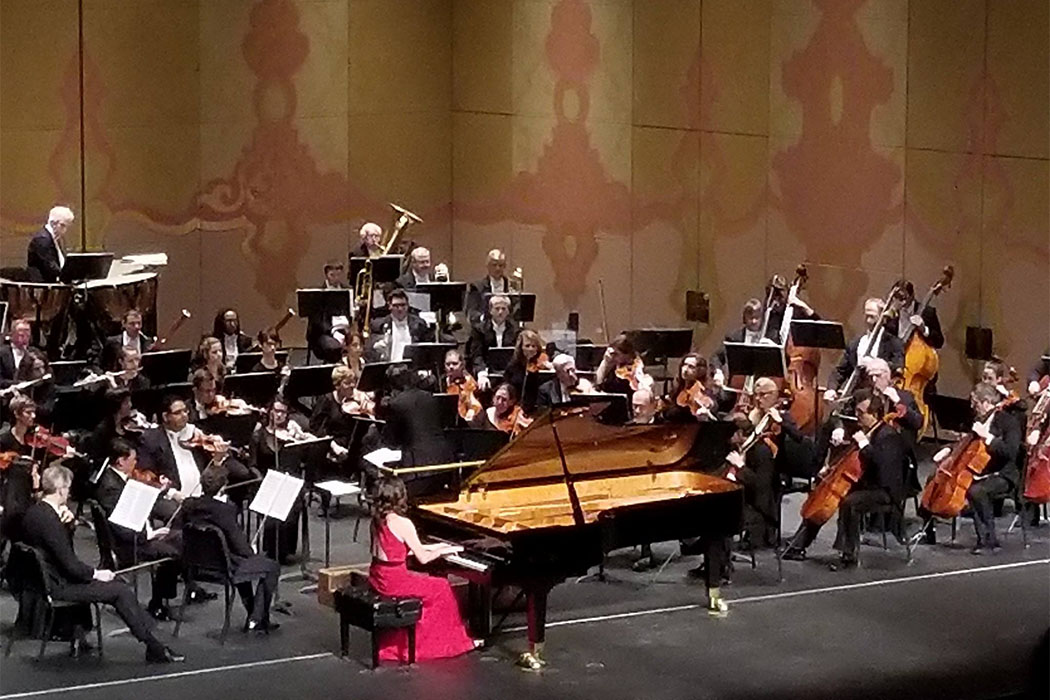Given the current revelations of the past week, I couldn’t help feeling that Maestro Aram Demirjian and the Knoxville Symphony Orchestra may have wished they had titled the week’s Masterworks concerts something other than “Russian Passion.” On the other hand, the music did come courtesy of three of Russia’s most admired: Tchaikovsky, Rachmaninoff, and Rimsky-Korsakov. And, what transpired on the stage of the Tennessee Theatre was definitely passionate—and magnificent—music-making.
Pianist Tanya Gabrielian joined Demirjian and the orchestra for Rachmaninoff’s Rhapsody on a Theme of Paganini, arguably the most compelling and entertaining of the dozens of works and stylistic treatments drawn from Paganini’s 24th Caprice for Violin. Compelling, too, was Gabrielian’s interpretation: bold and assertive without being ostentatious or heavy, yet with a strategic mastery of the contrast between intriguing little subtleties and serious pronouncements. There was no hesitation in taking on the work’s difficult runs and giving them a fluidity and sparkle—again, confident ownership of the virtuosic technique that Rachmaninoff built into his works for piano.
Although the delineation of the rhapsody’s groupings of variations was still noticeable, I admired the collaboration between Gabrielian and Demirjian in allowing the work to find a continuous arc. Admirable, too, was the gorgeous orchestral balance that did not sacrifice crispness for solidity. Of course, the 18th variation—the oh-so popular romance of the piece—comes upon the listener like a suddenly opened door revealing another time and place. In this case, one gives in to the schmaltzy melody—and luscious playing from the strings—without hesitation.
Gabrielian offered a lovely rendered encore in the Russian vein, “The Lark,” a transcription by Mili Balakirev of a song from the collection A Farewell to Saint Petersburg by Mikhail Glinka.
Making prefatory announcements and explanations at the beginning of the KSO concerts usually falls to Maestro Demirjian. However, on both Thursday and Friday evenings, violinist Sean Claire and principal oboe Claire Chenette, respectively, assumed that duty. For whatever reason on this occasion, having orchestra members address the audience is a wonderful way of breaking down the wall that separates those wielding musical instruments from those who aren’t. And, importantly, it makes it much more difficult for the listener to simply take the orchestra’s excellent musicians for granted. This seemed particularly important given the concluding work on the program, Rimsky-Korsakov’s Scheherazade, a work filled with substantial solo roles for orchestra members.
With the sub-title Symphonic Suite after “A Thousand and One Nights”, the orchestration masterpiece that is Scheherazade is constructed around a programmatic story taken from the ancient tales. The work begins with a bold ominous statement, but then introduces the instrumentalists and their motifs that define the character of the entire work. The solo violin, the voice of Scheherazade that subsequently opens and closes the work thematically, came from concertmaster William Shaub in a performance that was superb in its haunting emotion and drama, gorgeous tone, and impeccable intonation. Appearing throughout were the other motif voices, splendidly rendered with captivating character: oboe (Claire Chenette), horn (Jeffery Whaley), flute (Hannah Hammel), clarinet (Gary Sperl), bassoon (Aaron Apaza), and cello (Andy Bryenton).
Demirjian also kept the work paced, varied, and lovingly balanced, giving the orchestration’s textural character an ebb and flow that keeps the intrigue alive all the way to the intense final climax— a climax that gives way to violinist Shaub’s heart-tugging conclusion.
The evening of “passion” opened with Tchaikovsky’s “Rose Adagio” from the ballet The Sleeping Beauty.







